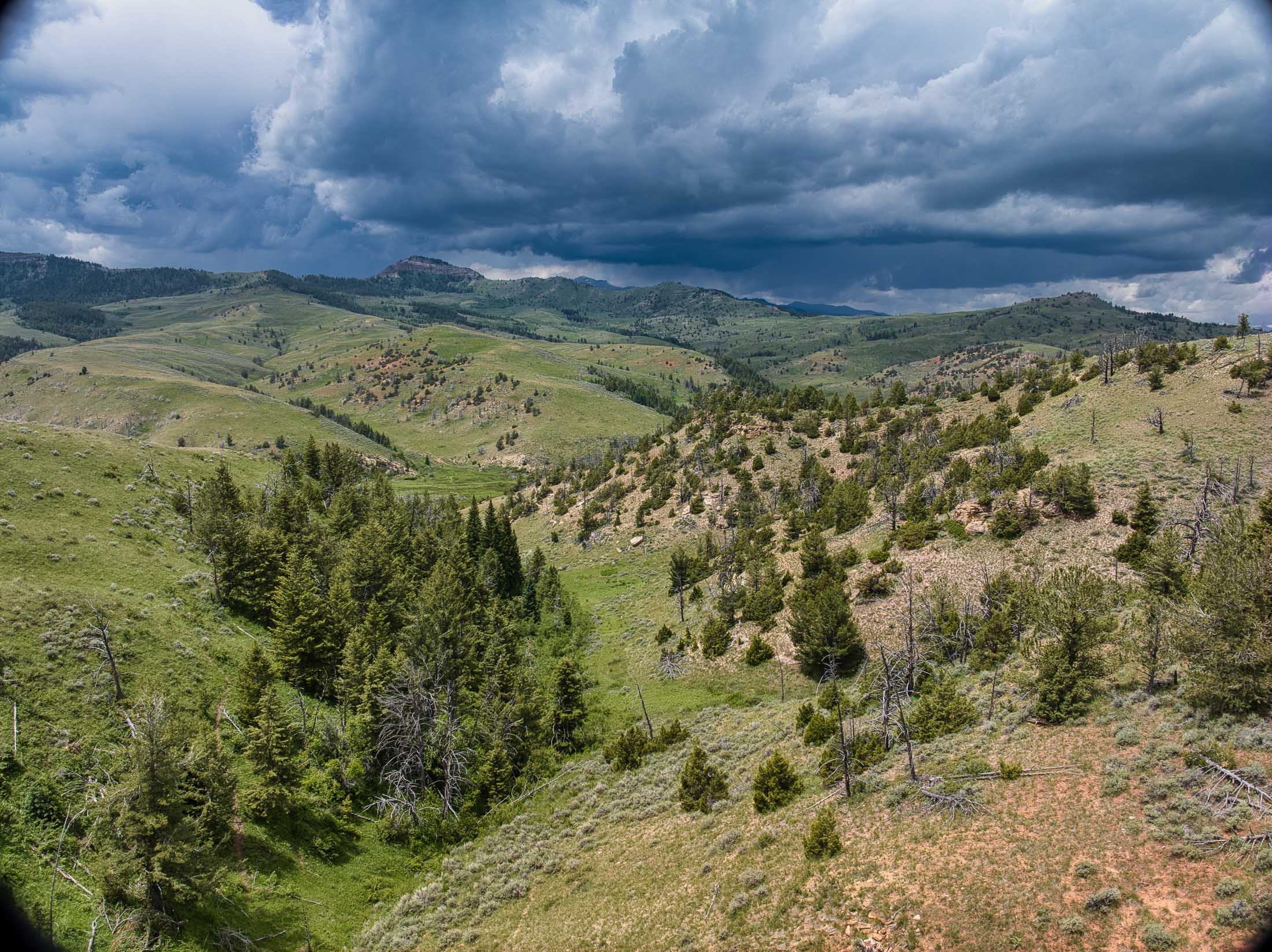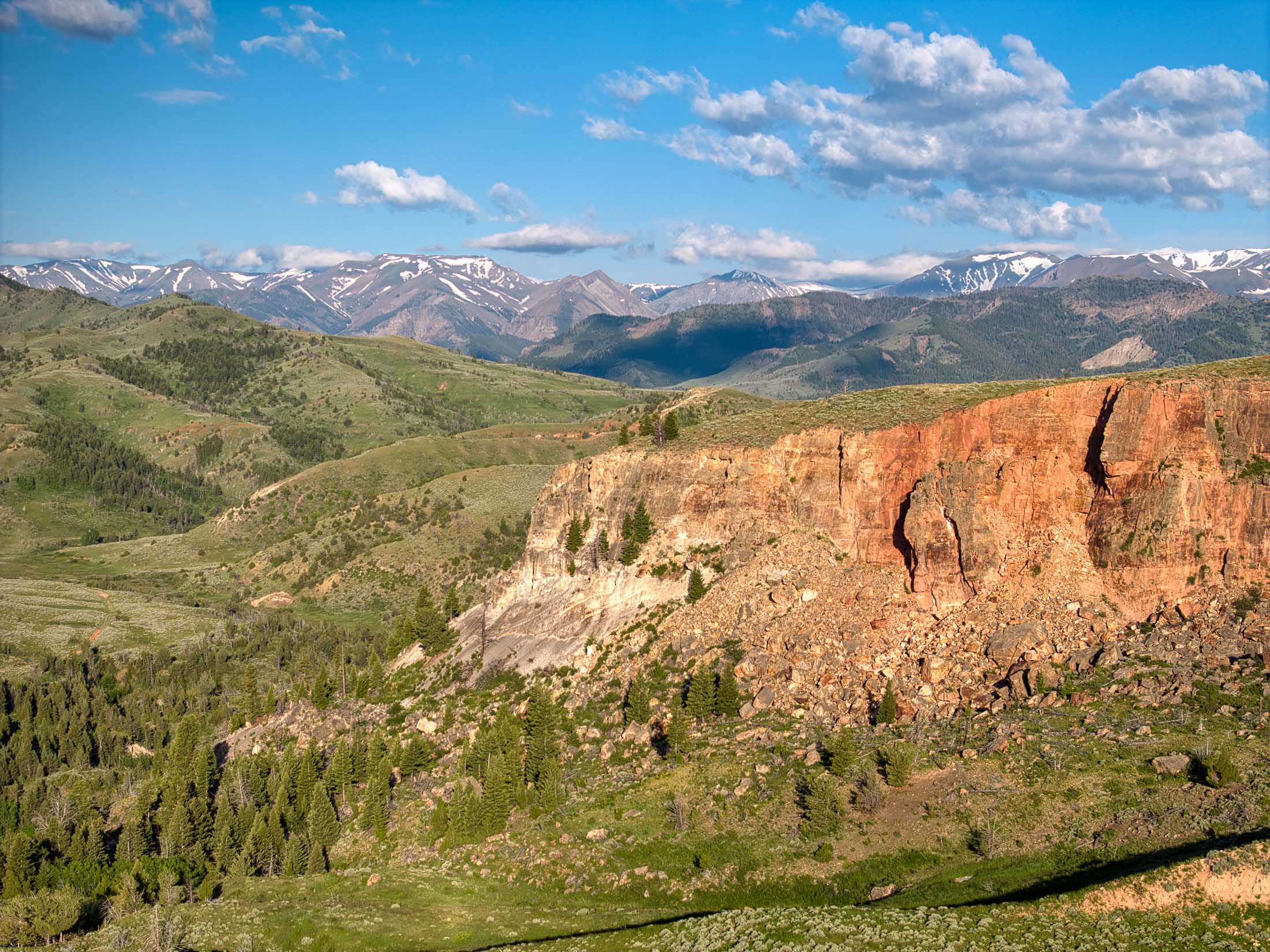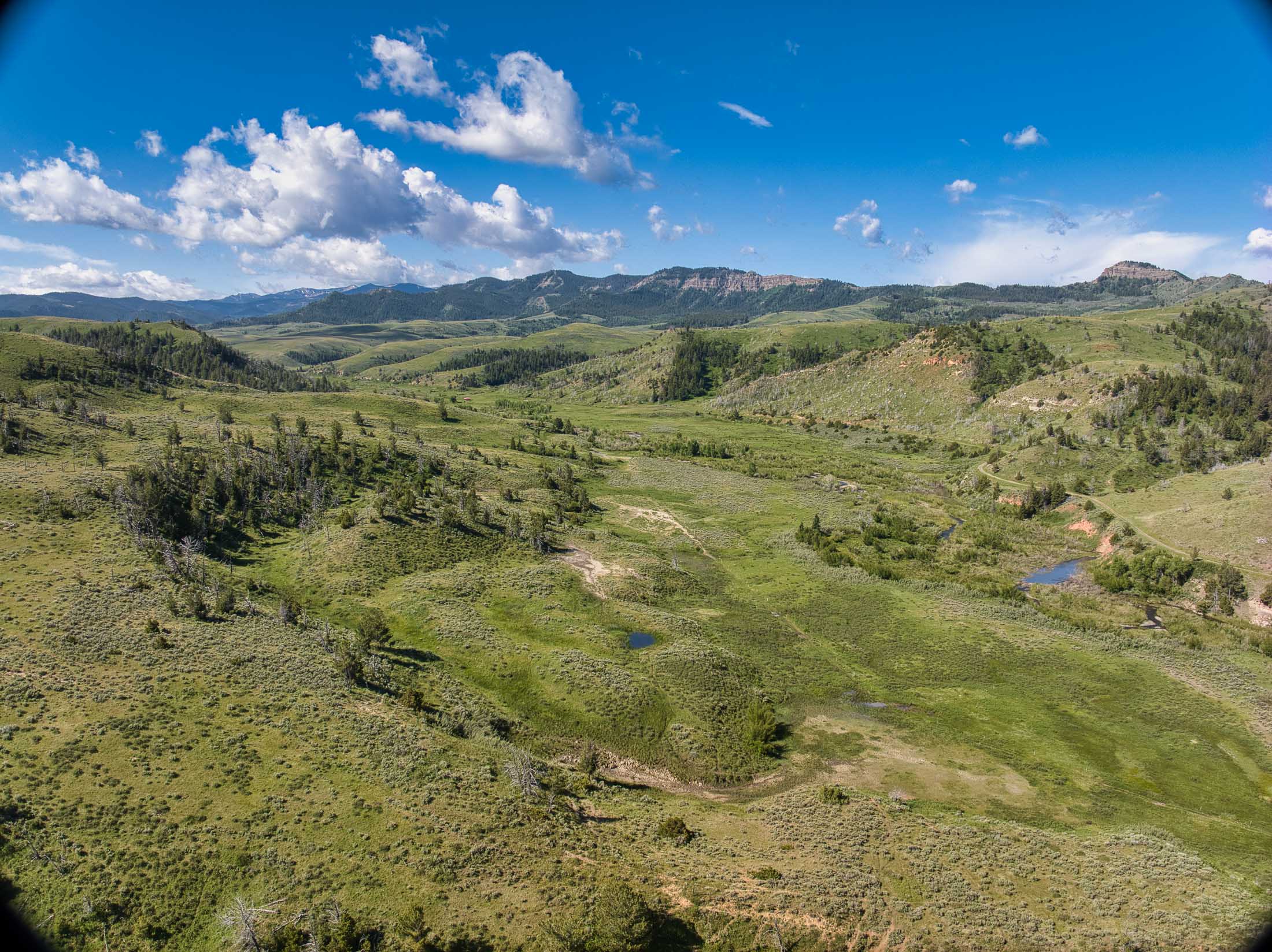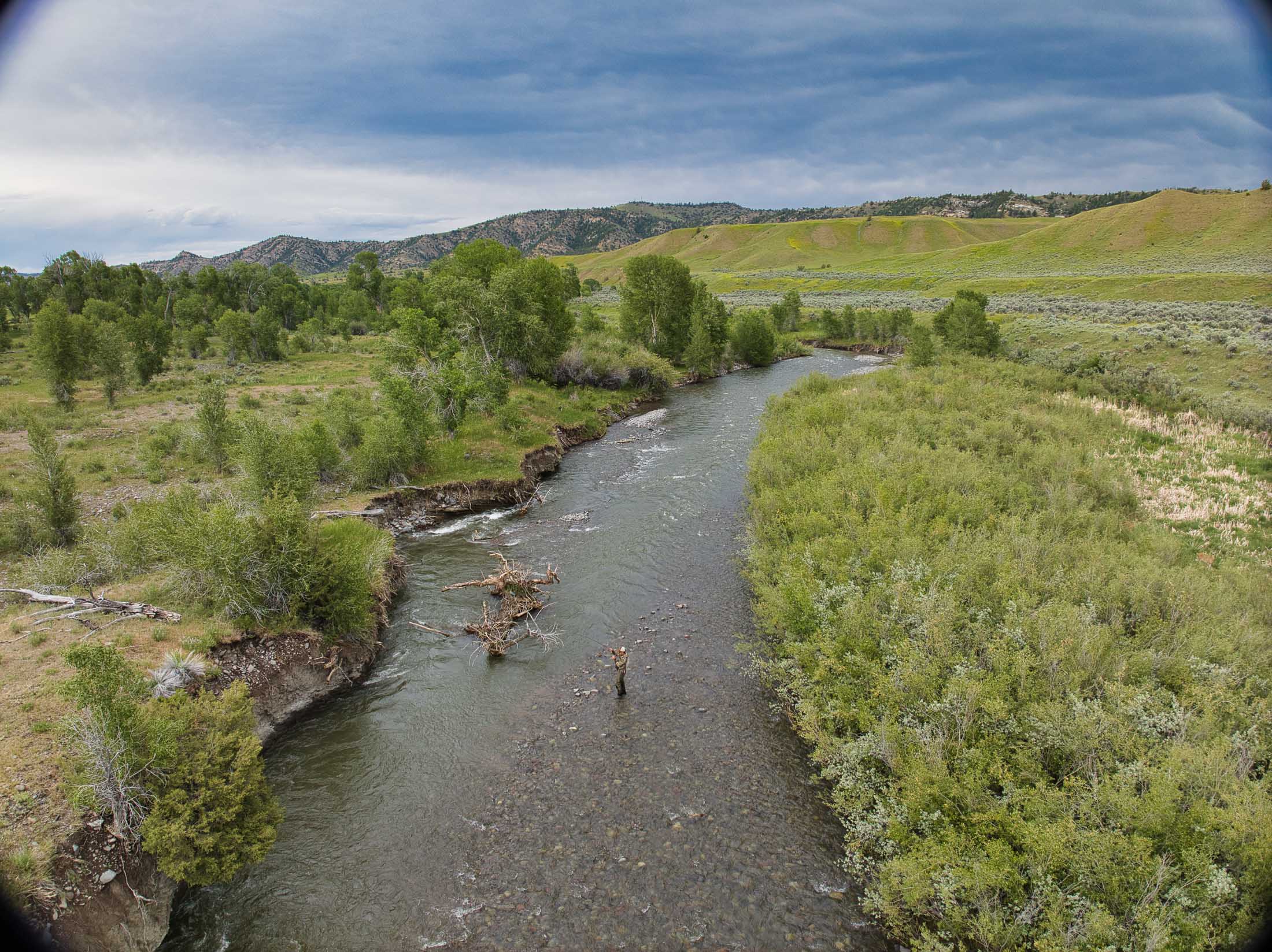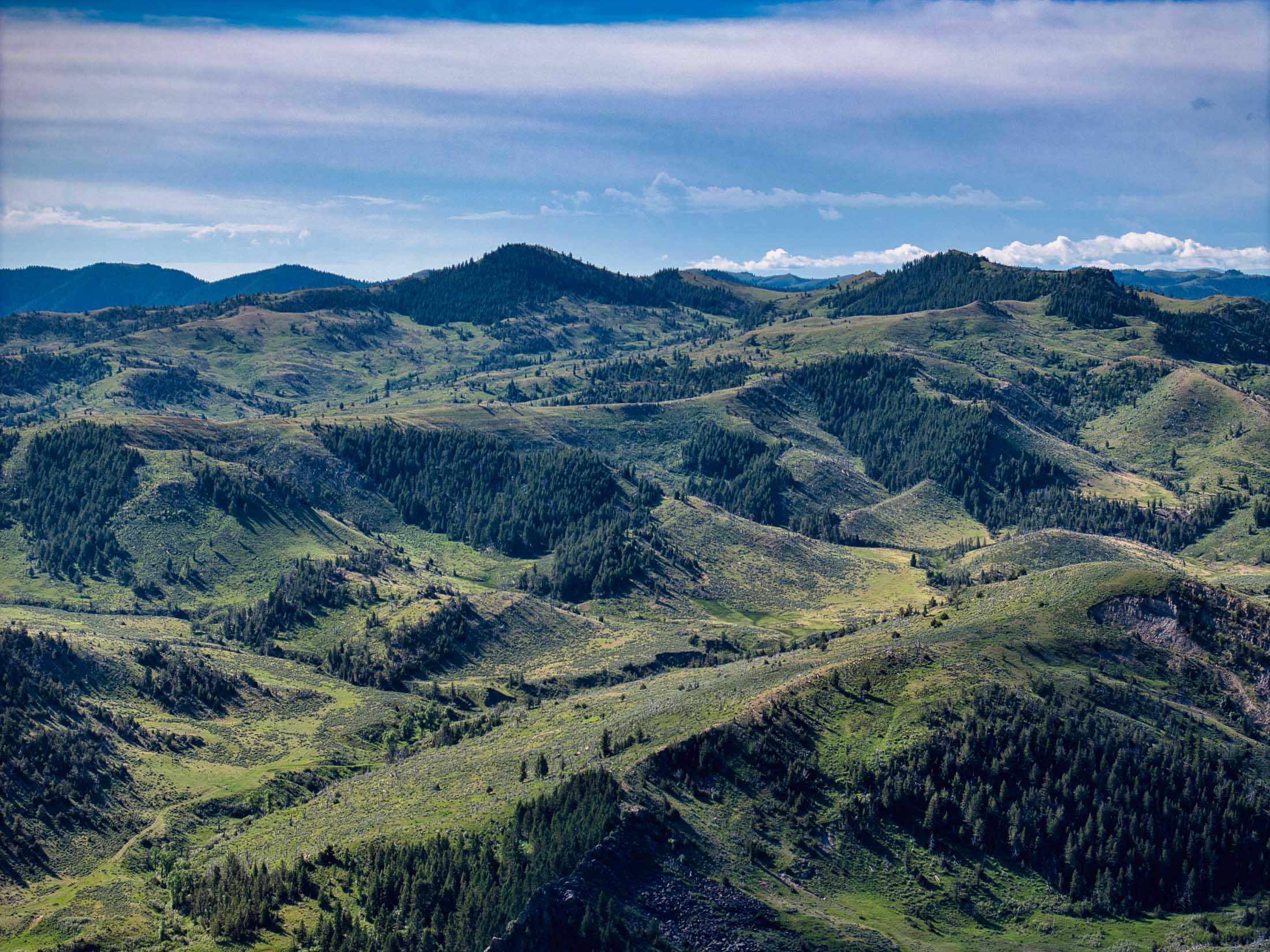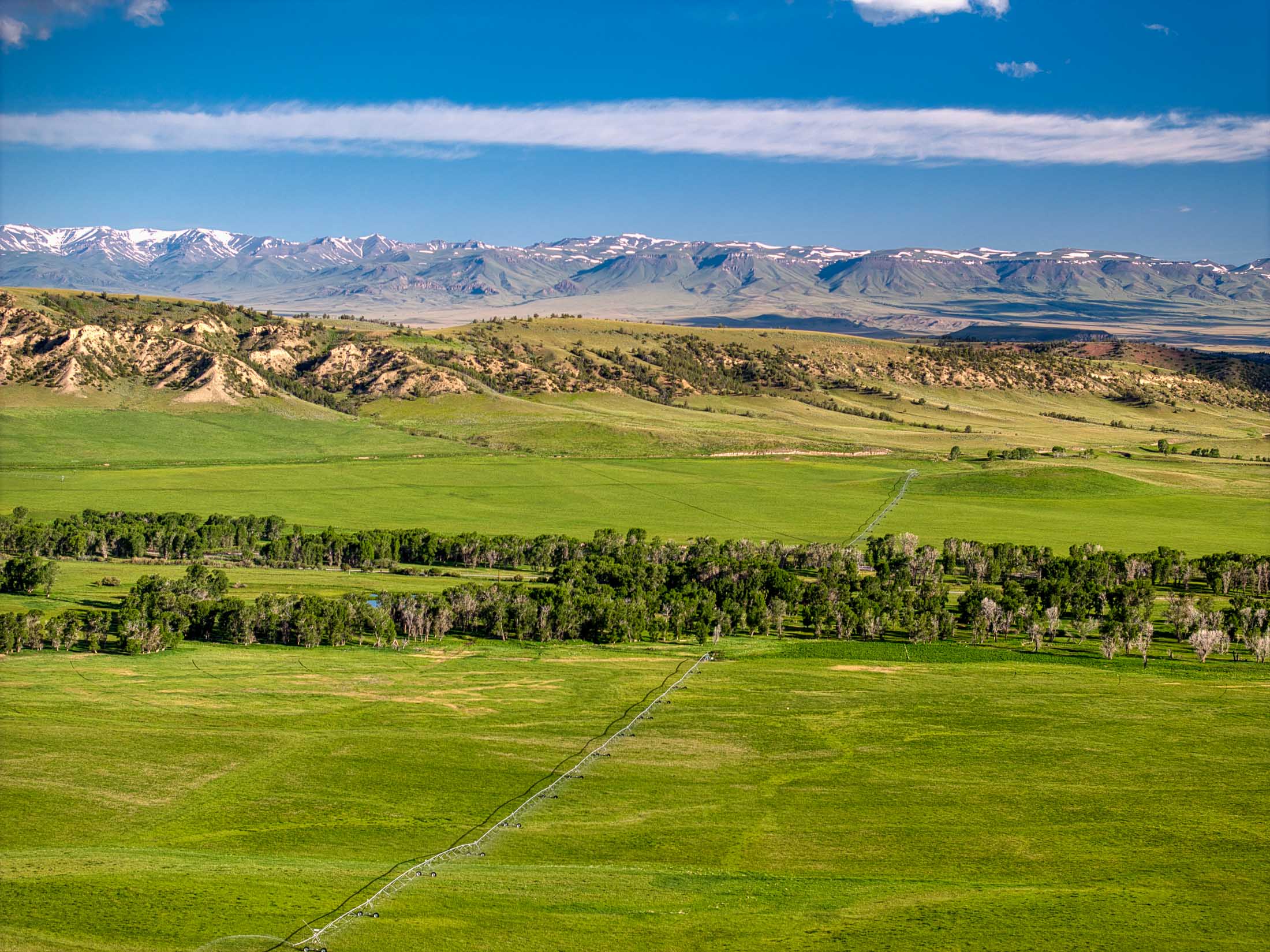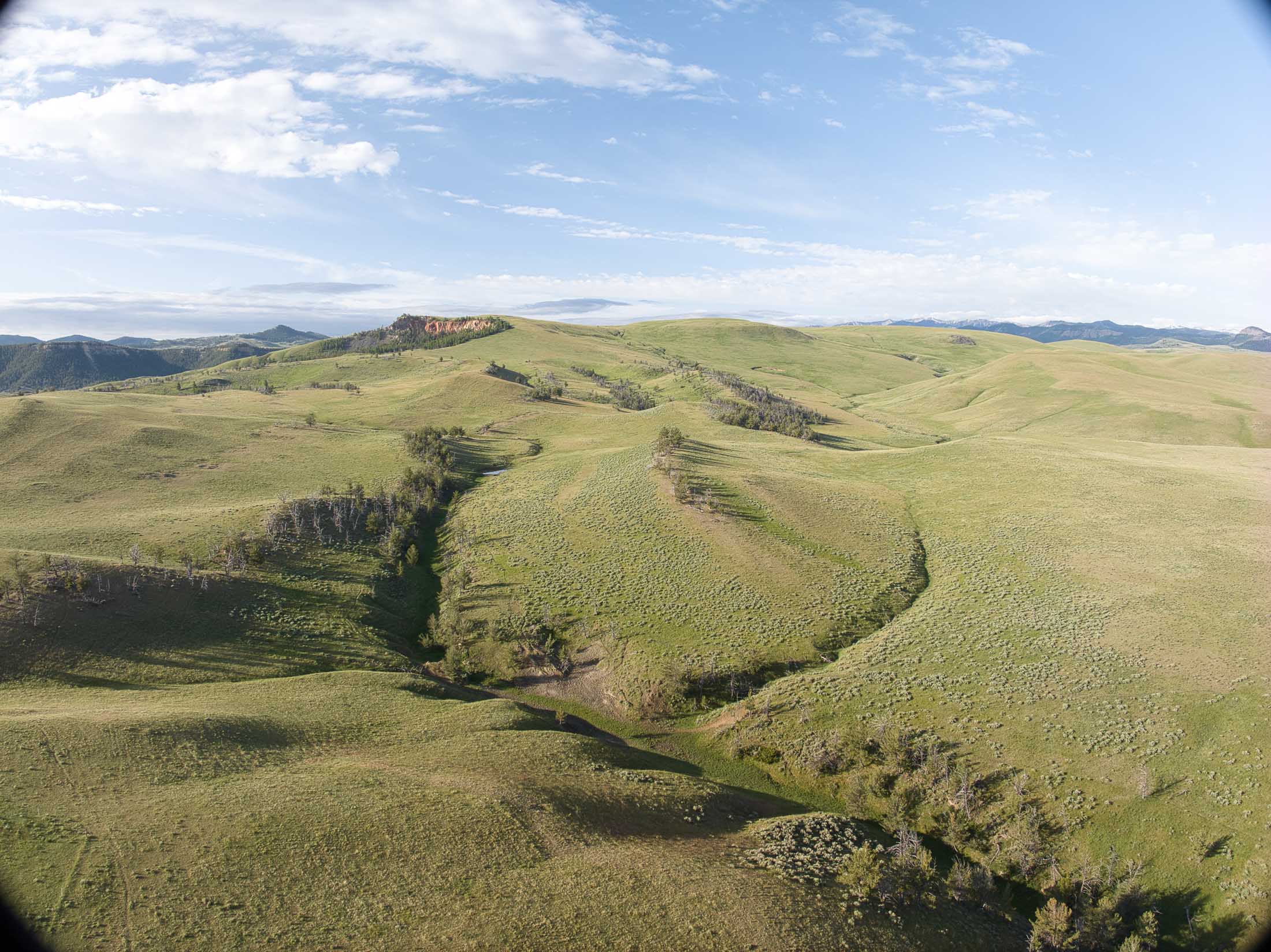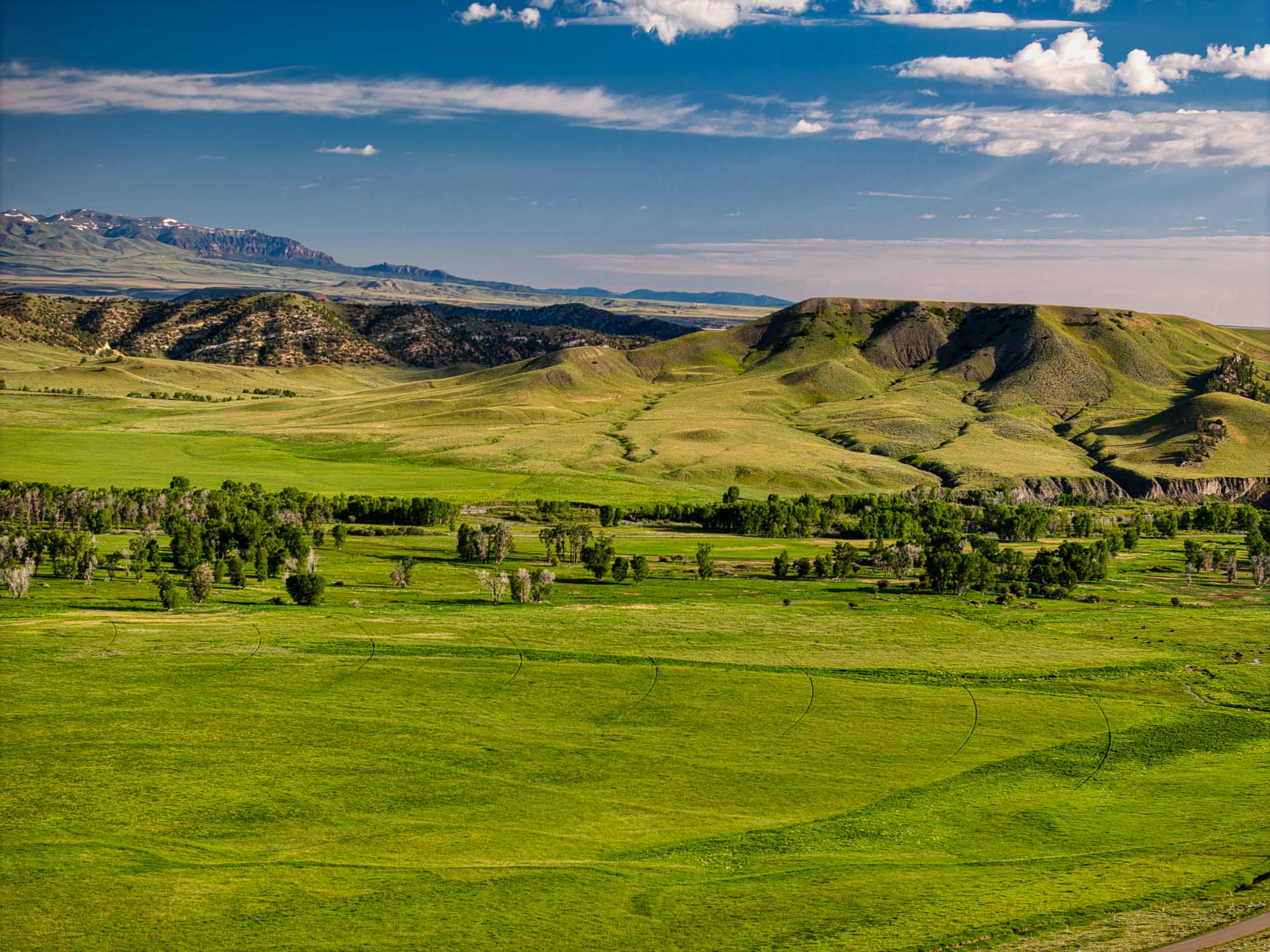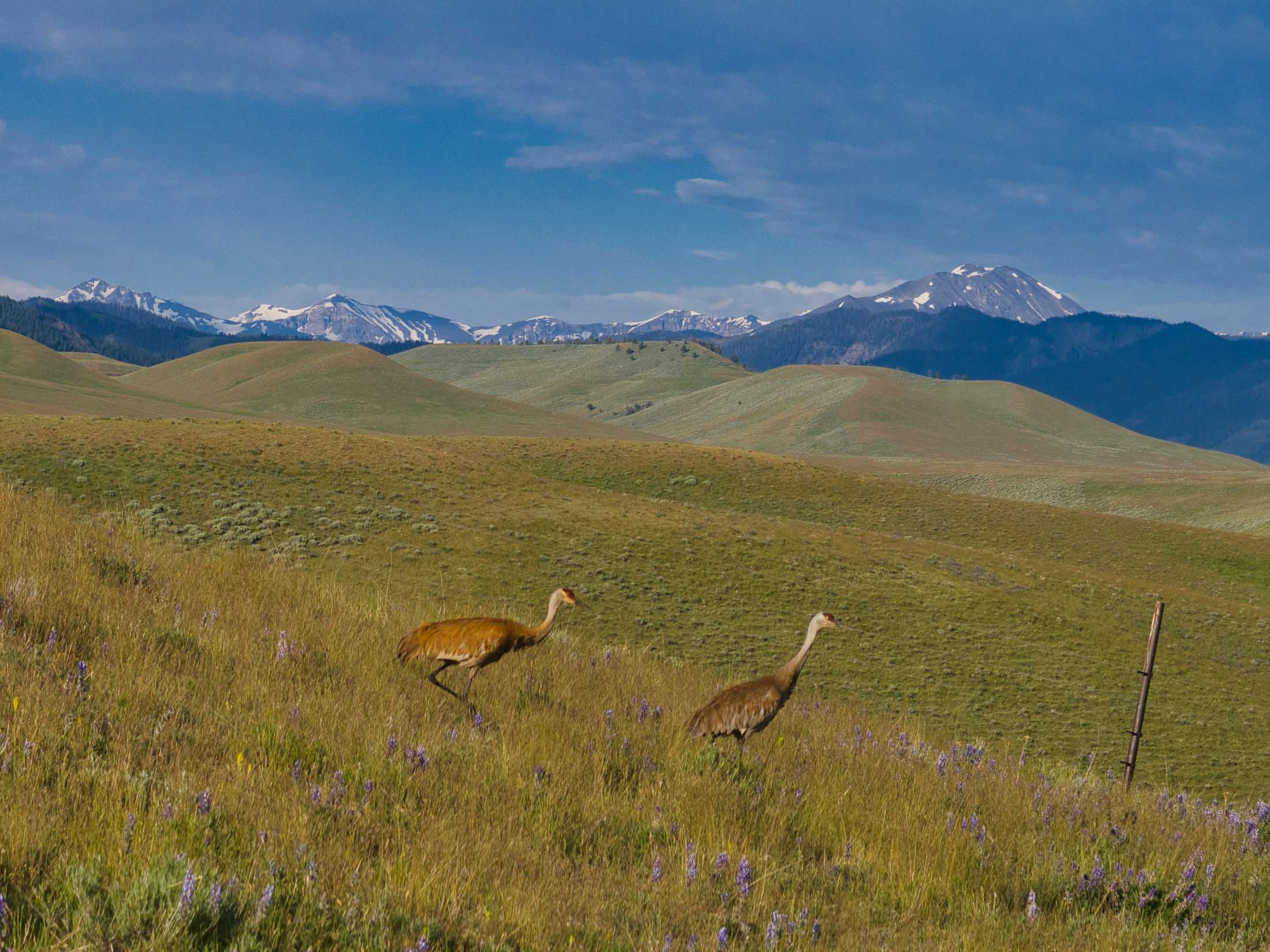Antlers Ranch
Antlers Ranch is one of the West’s legacy ranches—the May family has worked, stewarded and loved this land since 1895. With 16,532 deeded acres, control of more than 40,000 acres and approximately 63 miles of shared border with federal- or state-protected lands, Antlers Ranch functions as both a working ranch and a wildlife sanctuary where everything is at peace. Antlers has a diversity of topography and habitats ranging from river bottoms to irrigated pastures and timbered alpine peaks that are home to wildlife like moose, elk, antelope and white tail and mule deer. 18 miles of private live water, with territorial water rights ensuring consistent hay production and guaranteeing the fly fishing here is as spectacular as the opportunities to hunt trophy big game animals. It’s a Little Yellowstone.
A RANCH WHERE HISTORY HAPPENED
Governors, senators and even a vice president know this Ranch. So too do ranch hands, cowboys and ranch foremen across the state and West. The Antlers Ranch’s story is synonymous with the story of the American West. Founded by a German immigrant who, in 1868 traveled up the Missouri River on a flatboat to Fort Benton, Montana to work as a prospector in gold fields, the Antlers Ranch started in 1895 as an outfit to feed miners prospecting for gold in Kirwin, further up the Wood River Valley. Ernest May Sr. soon traded his interest in the mining company that owned Antlers for sole ownership of the Ranch and it has been under the stewardship of the May family ever since. The third generation of Mays was president of the Wyoming Cattle Association and was integral to making Wyoming known as a cattle producer (in addition to a producer of gas and minerals).
Subsequent generations have grown the Antlers Ranch, and each of the smaller ranches that it absorbed are still known by their original names today. “We left the names intact out of pure respect for the hard work and self dedication those people put into building their lives and ranches here,” 5th generation May rancher Sam May says. “Here, in Wyoming and on this Ranch, respecting and honoring the past isn’t just something to be talked about, but something we seek to do justice to.”
From River Bottoms to Alpine Ridges
There are bigger ranches than Antlers, which has about 40,000 controlled acres, including 16,532 deeded acres, but to find a place equal to Antlers’ diversity of habitats and elevation you have to look to a national park or national forest. The difference in elevation from the Ranch’s lowest point, the Wood River, to its highest, 8,480-foot tall Noon Point in the Absaroka Mountains, which form the eastern boundary of Yellowstone National Park, is more than 2,000 feet, a vertical rise greater than that of many ski resorts. At Antlers Ranch there are the cottonwood-lined river bottoms and grazing meadow habitats most often associated with ranches, and also, higher up, wildflower-covered hillsides, timbered ridges, and granite slopes. From high points at Antlers, you can see Francs Peak (13,153 feet), which is the highest point in the Absarokas, and also the Owl Creek and Bighorn Mountains. Antlers Ranch is a testament to the beauty and diversity of Wyoming’s natural landscapes and ecosystems.
The 23,500-some acres of federal and state land adjacent to and controlled by the Ranch total 63 miles of shared border. These parcels help ensure protected viewscapes for perpetuity.
A PRIVATE FLY-FISHING PARADISE
A river runs through Antlers Ranch. And so do three creeks. Totaling 18 miles, thanks to Wyoming stream law (which states that landowners own streambeds) these four fisheries are 100% private. The Ranch’s owners can grant public access agreements, but there are not any currently in place, helping create some of the finest dry fly fishing in the West.
Wood River
Approximately 6 miles of the Wood River flow through the Antlers Ranch’s deeded lands with another 3/4-mile on state land within its boundaries. The Wood, a classic freestone stream, is a pure, self-sustaining cutthroat fishery with riffles, runs, pools, numerous braids, side channels and undercut banks. There are excellent hatches of Stoneflies, Mayflies, Caddis and midges with Yellowstone cutthroat present in all class sizes.
Gooseberry Creek
The character of the approximately 7.25 miles of Gooseberry Creek on Antlers Ranch is diverse. Portions of the creek are willow-lined with multiple braid and side channels, undercut banks, lazy bends and runs. There is also a canyon with rock walls and a classic pocket water setting. All stretches are home to brook trout in the 8-14” range. Gooseberry Creek is perfect for wet wading with a 3-weight and casting flies to trout that have never been fished to.
Dick Creek
In the wildlife-rich Dick Creek Valley on the Ranch’s western side, Dick Creek is more intimate in size than Gooseberry Creek but big on views. Home to cutthroat, Dick Creek is a prime candidate for stream enhancement, if the Ranch’s next owner is looking for an interesting project. About 2.75 miles of Dick Creek are on the Ranch’s deeded lands.
Stonewall Creek
The fishable reach of Stonewall Creek measures approximately 2 miles on deeded lands. Its flow is supplemented by irrigation water, which flows into the creek and then down to Lower Sunshine Reservoir. This nuance presents an interesting seasonal opportunity to target large lake fish as they run up out of the reservoir and into Stonewall Creek to spawn.
Wyoming’s official state fish, the cutthroat trout, is the only species of trout native to the state and is prized among fishermen for its voracity and willingness to take a dry fly from the water’s surface. Its name comes from the bright slash of red on the underside of its jaw, and its scientific name, Oncorhynchus clarki, traces back to William Clark, of Lewis and Clark, who gave one of the earliest descriptions of the fish. There are four subspecies in Wyoming—the Colorado River, the Bonneville, the Snake River, and Yellowstone cutthroat. But cutthroat trout populations are reeling. There were 14 unique subspecies of the trout that evolved in western North American waters. Two are extinct. None is faring all that well. That two of the Antlers Ranch’s fisheries have healthy cutthroat populations is rare and remarkable, and a clear indicator of the health of these waterways.
A LITTLE YELLOWSTONE
About 330 species of wildlife, including grizzly and black bears, gray wolves, deer, elk, moose, pronghorn, Marriam turkeys, bald and golden eagles, coyotes, Clark’s nutcrackers and peregrine falcons live on or pass through Antlers Ranch. The Ranch is part of the 22-million acre Greater Yellowstone Ecosystem, which is home to all of the native flora and fauna that lived in this area prior to the arrival of Europeans and one of the last remaining intact ecosystems on Earth. Antlers Ranch is a private “Little Yellowstone.”
GAME AS BIG AS THE LANDSCAPE
Antlers Ranch is not just a livestock ranch. Since its foundation, it has looked at all of the animals and conscientiously managed the populations of big game, one of the ranch’s finest attributes. “We’ve taken a much more balanced way of caring for the land,” says Sam May. “There aren’t many ranches where you will see deer or moose in the middle of your livestock. I like to think everything is working like it is supposed to. Everything is at peace.”
The Antlers Ranch has historically qualified for landowner tags in Wyoming elk units 62 and 63 (considered among the best units in the western U.S. for trophy elk), and deer units 116 and 118; its owner and immediate family might have these opportunities every year.
To propagate the best genetics in the game animals on the ranch, the Mays have strictly controlled the amount of hunting on the property. There were decades when Antlers did not allow any hunting. Since the mid-1990s, limited hunting has been allowed for game management purposes with a maximum of 5 bull elk and 5 whitetail bucks permitted to be taken in a given year. Consequently, bull elk over 380 inches, whitetail deer over 170 inches, mule deer over 190 inches, and antelope surpassing the minimum score for Boone and Crockett have been harvested on the Ranch.
DIVERSIFIED REVENUE STREAMS
Antlers Ranch is as diverse in its revenue generation as it is in topography, with 5 distinct income streams: bison, hay, minerals, hunting and fishing and gravel.
“And on the 8th day, God looked down on his planned paradise and said, ‘I need a caretaker.’ So God made a farmer.”—Paul Harvey in a 1978 speech to the Future Farmers of America.
Bison
For more than a century, the Antlers Ranch brand was synonymous with beef production in the Wood River Valley. Historically the ranch ran 700-750 head of cattle year-round. In 1997, Michael May “switched horses” and evolved the ranch to a bison operation, recognizing that bison require little labor, they calve on their own, and, at least on the Antlers, rarely require winter feed. Today Antlers Ranch runs approximately 650-700 head of bison and the elder May’s decision has proved to be a good one financially. Bison calves are sold in the fall and additional income comes in by allowing limited bison hunts, which also helps cull the herd. Beyond the financial benefits, returning these animals to their native range has created an even more majestic setting at Antlers Ranch.
Hay
The Ranch puts up hay on approximately 1,200 acres, of which approximately 1,000 are serviced by 15 center pivots and supplemented by 7-wheel lines and gated pipe. It should be noted, the majority of the Ranch’s water rights date back prior to statehood, deeming them Territorial Rights and alleviating any concern of loss or curtailment. Hay yields have typically been in the 2 ½ -3 tons per acre range; depending on the year, there are one or two cuttings. Because bison require less winter feed than cattle, many years Antlers Ranch is able to sell 100% of its hay production on the open market, or stack it in the Ranch’s covered storage to capture better pricing in the future.
Minerals
The ranch benefits from income producing oil wells governed by lease agreements with Breitburn Operating, LP. Wells are consolidated on the north end of the Ranch. Antlers Ranch has Right of Production on the mineral estate, which provides an opportunity for the next owner to increase oil revenue.
Hunting & Fishing
Hunting and fishing have been carefully managed on Antlers Ranch. The May Family has prioritized the quality of the wildlife resource ahead of monetary gain. Presently there is a year-to-year hunting lease with a well-respected outfitter that allows for the harvest of up to 5 bull elk and 5 whitetail bucks. This lease also allows for limited fishing on a fee basis.
Gravel
The Antlers has a modest on-site gravel pit that generates material that can be sold or utilized on the ranch road network.
SET FOR SUCCESS
Antlers Ranch has housing for its owners and staff and all of the built infrastructure required for it to be a successful working ranch.
The Ranch’s living headquarters includes two homes: 1. The primary owner’s home was built in 1937 and remodeled in 2012. 2. The secondary owner’s home is historic; it was built in 1916. The location of these two homes offer expansive views of the Absaroka Mountains, a sizable fishing pond and mature landscaping (including cottonwoods and a manicured, irrigated lawn). These homes are easily accessible year-round via a well-maintained road.
There are three homes that could be used for staff or guests, or rented on platforms like VRBO or AirBnB: a bunkhouse, a duplex and 2 ranch-style homes.
Antlers Ranch’s production headquarters are 2 miles up County Road 4DT from the 2 owner’s houses. Production headquarters include an employee house; a 7,200-sf heated shop with multiple bays and a bathroom; a 7,200-sf equipment shed; a 3,072-sf Quonset hut for storage; 2 hay sheds, each spanning 9,000-sf; and a 1,944-sf butcher shop/meat processing facility with walk-in coolers, a cleaning station, water, heat and a hoist lift. An impressive corral system with welded pipe, hydraulic gates, loading ramps, an indoor veterinary station, a certified scale and strategically placed alleys accommodates bison, cattle or horses. Finally, there are grain bins, small sheds and miscellaneous structures that contribute to Antlers Ranch being a successful and turn-key operation.














